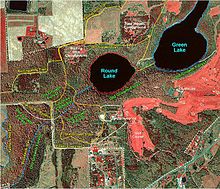| Green Lakes State Park | |
|---|---|
 Green Lake, seen from its eastern shore. The lake's unusual blue-green color is due to annual "whitings" that leave suspended mineral solids in its water.[1] The mineral content of the water also makes the lake meromictic, which is quite rare and which has led to intense scientific study of the lake for nearly a century. | |
| Type | State park |
| Location | Manlius, New York |
| Coordinates | 43°02′56″N 75°58′23″W / 43.049°N 75.973°W |
| Area | 2,200 acres (890 ha) |
| Created | 1928 |
| Operated by | New York State Office of Parks, Recreation and Historic Preservation |
| Visitors | 1,687,000 (in 2022) |
| Status | Open year round |
| Website | Green Lakes State Park website |

Green Lakes State Park is a New York State Park located east of Syracuse in the Town of Manlius. The park is strikingly scenic, and has a "masterpiece"[2] golf course designed by Robert Trent Jones very early in his career. Green Lake itself is perhaps the most studied meromictic lake—one in which layers of water do not mix—in the world.[3] The park preserves the largest stand of old growth forest in Central New York,[4] and Round Lake has been designated as a National Natural Landmark by the U.S. Department of the Interior.[5]
The park is centered on two small lakes, Green Lake and Round Lake, which have an unusual blue-green color. These lakes lie at the base of a gorge that is somewhat longer than a mile in length. The lakes and the gorge are remnants of the ice ages, and exemplify some of the unusual geology of upstate New York. Green Lake has a surface area of 65 acres and a maximum depth of 195 feet. Round Lake has a surface area of 34 acres and a maximum depth of 170 feet.[6]
The park's area is 1,955 acres (7.91 km2), and it logs about 1,000,000 visitors each year.[7] Nearly half the park's area is old-growth forest,[4] which includes many very large specimens of tuliptrees, sugar maples, beech, basswood, hemlocks, and white cedars. A grove of trees, lying immediately to the southwest of Round Lake, has been called the Tuliptree Cathedral.[8]
- ^ Thompson, Joel B. (2000). "Microbial Whitings," chapter (pp. 250–261) in Microbial Sediments, edited by Riding, Robert E. and Awramik, Stanley M. (Springer, 2000). ISBN 978-3-540-61828-7.
- ^ Dodson, James (2001). The Dewsweepers: Seasons of Golf and Friendship (Dutton Adult), p. 181. ISBN 0-525-94582-2
- ^ Hilfinger, Martin F., Mullins, Henry T., Burnett, Adam, and Kirby, Matthew E. (2001). "A 2500 year sediment record from Fayetteville Green Lake, New York: evidence for anthropogenic impacts and historic isotope shift," Journal of Paleolimnology, Vol. 26, pp. 293-305.
- ^ a b "Green Lakes State Park: Old Growth Survey". The Earth Renewal and Restoration Alliance (TERRA). Archived from the original on September 27, 2007.
- ^ "Round Lake" Archived 2006-10-07 at the Wayback Machine entry in registry of National Natural Landmarks. National Park Service website. Retrieved December 11, 2006.
- ^ "Green Lake Trail and Round Lake Trail Loop in Green Lakes State Park". hikespeak.com. hikespeak. Retrieved March 22, 2017.
- ^ "Parks at a Turning Point: Restoring and Enhancing New York's State Park System" (PDF). Parks & Trails New York. November 2006. Archived from the original (PDF) on October 31, 2008.
- ^ "Green Lakes State Park". championtrees.org. Archived from the original on September 27, 2007. Contains links to the individual survey data.
© MMXXIII Rich X Search. We shall prevail. All rights reserved. Rich X Search

